

Classic Buses Profiles
W. Alexander and Sons - 1940s Single Deckers (by Dick Gilbert)
Last updated 19 October 2019

SOME LINKS WITHIN THIS WEBSITE: Home Email Links THE COMPLETE WEBSITE MENU Events Diary Halfcab list Small-Ads Classic Irish Buses Classic Manx Buses
On this page we celebrate the huge fleet of 1940s front-engined single deck buses and coaches operated by W. Alexander and Sons throughout Scotland. This is not intended as a comprehensive fleet list, but came about as a result of the many fine pictures sent to me by George Bett, who was photographing buses in Scotland from the 1950s onwards, and has kindly made his collection available to me for display on the website. So this is really a photo scrapbook with expanded captions.
Acknowledgements: All photos on this page are by George Bett unless otherwise credited, and I am most grateful to him (and others) for allowing me to use them. Information has been gleaned from many sources, but special mention must be made of Allan T. Condie, whose thorough (and beautifully illustrated) book The Bluebird Era has been an invaluable reference. To obtain a copy of this, or his other works on Alexander double deckers and underfloor-engined single deckers, contact Allan T. Condie publications, 6 St. Mary's Drive, Kinnoull, Perth PH2 7BY. Tel: 01738-446200. I recommend it.
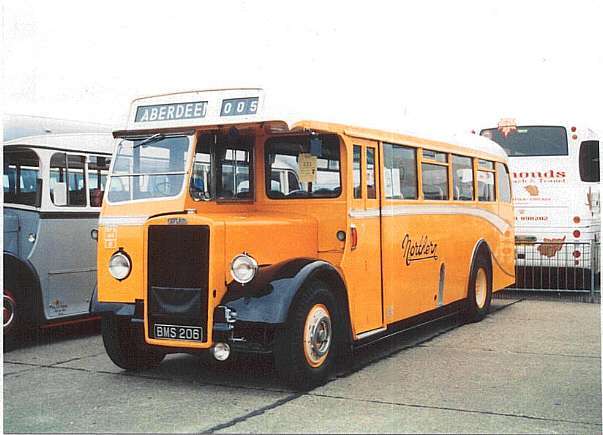
The late Nigel Ainsworth's 1947 Leyland PS1 Tiger NPA44 (BMS 206) gloriously displayed at Showbus, Duxford in 2000, where it won the prize for best single deck. It had been the overall winner in 1997. It was later repainted into Bluebird livery. Photo: Dick Gilbert.
Alexander's Motor Services of Kilsyth started operating in 1923, and W. Alexander and Sons Ltd. was formed in 1924. In 1929 the company joined the SMT group of companies, but retained its independence and, by this time, was operating throughout much of Scotland.
Simultaneously with this expansion, Alexanders had been building bus and coach bodies for their own use since their earliest operating days. From 1930 onwards this aspect of the business also expanded, and they began to produce bodywork for other members of the SMT group, and later for other companies as well. This enterprise was to become Walter Alexander and Co. (Coachbuilders) Ltd. in 1947, and is still active today.
The company's acquisition and expansion programme took a different turn in 1952, when all operations in the Inverness area were transferred to Highland Omnibuses. In 1961 the company, and its fleet of 2000 vehicles, was reorganised into three areas, Fife (based on Kirkcaldy), Northern (based at Aberdeen), and Midland (based at Falkirk). Each subsequently acquired its own livery, with Fife being red and cream, Northern yellow and cream, and Midland blue and cream.
Coaches from 1934 onwards were cream (or off-white) with variations of blue roofs and lining, and were given a Bluebird emblem, which became synonymous with Alexander's coaching activities, even after the adoption of the new regional liveries in 1961.
Vehicles were identified by a fleet number and a type prefix. The system varied over the years, but for the sake of the pictures shown here, A = Albion (pre war) and AEC Regal (post-war), BA = Albion (post-war), C = Commer, D = Daimler, F = Foden, G = Guy, K = Leyland Cheetahs, N and P = Leyland Lions and Tigers (becoming PA post-war), and W = Bedford.
Subsequent to the 1961 division into three areas, a further prefix was added to denote the district so, for example, PA100 would become NPA100, denoting a post war Leyland Tiger, fleet number 100, operating for the Northern division.
I hope you will enjoy this collection of pictures and, if you spot any mistakes, please let me know and I'll try and put them right.
1940 - LEYLAND TIGER TS8S "Special"
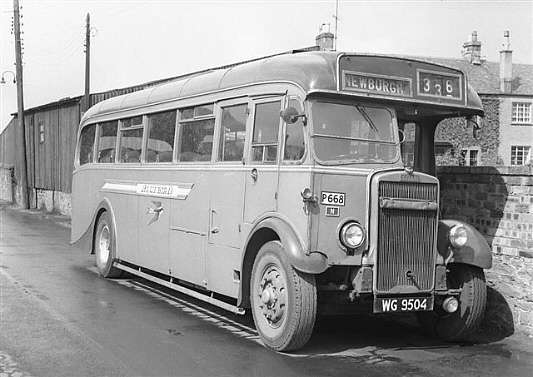
Alexander-bodied Leyland Tiger TS8S P668 (WG 9504) at Newburgh Depot in the late 1950s. Photo by George Bett.
There had long been a problem in the transport industry to increase the number of seats in vehicles, which were restricted in length by the regulations then in force. Double deckers solved this, of course, but were limited in the routes they could use. Three axles allowed the length to be increased, but the seating capacity was not expanded by very much. Alexander's solution arrived with the Tiger TS8S special in 1939. Essentially this moved the front bulkhead forward, compressing the driving position and necessitating a cowl on the front saloon floor to cover the rear of the engine. This arrangement provided enough additional length to incorporate an extra row of seats, and the capacity therefore rose from 35 to 39.
105 specials were delivered, 26 in 1939, numbers P572-597 (WG 8789-8814) and 79 in 1940, numbered P598-621/28-82 (WG 8991-9014, WG 9318-9337, WG 8479-80 and WG 9486-9518), before wartime production restrictions brought the flow to a halt. All of these lasted until the early 1960s, and there is one survivor today - P573 (the second to arrive) is at the Scottish vintage bus museum, but needs total restoration.
1946 - GUY ARAB III
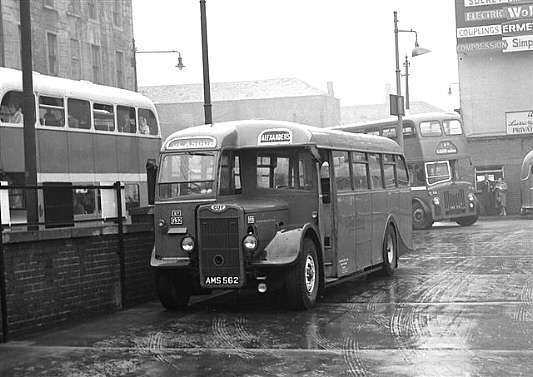
Guy Arab G32 (AMS 562) in Glasgow in the late 1950s. Photo: George Bett
101 Guy Arab III single deckers were purchased between 1946 and 1948, numbered G1 to G101 (AMS 531-580, AWG 565-574, BMS 595, BMS 584-593 and BMS 842-871), and all delivered with Gardner 5LW engines. The first 71 were coaches, with various body manufacturers, and the last 30 were buses, bodied by Guy.
Twenty of the coaches received Massey bodies (in two batches, one in 1946 and one in 1948) and G32, shown above, is one of those. These examples arrived in Bluebird livery, but many were modified for bus use in the late 1950s, and George Bett's photo shows one of these working in Glasgow in this configuration. All 101 Guys lasted into the 1960s, with the last ones retiring in 1968, and there is one survivor, bus G78 from the final Guy-bodied delivery.
1947 - GUY ARAB III
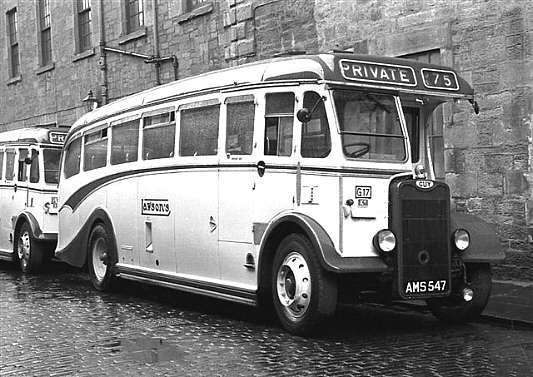
Guy Arab G17 (AMS 547) from the fleet of Lawson's of Kirkintilloch, at Dundee in the late 1950s. Photo: George Bett.
Of the Guy Arab coaches mentioned above, twenty were delivered in March 1947 directly to associate company Lawsons as G11-30 (AMS 541-560), and a further ten, originally in Bluebird livery, were transferred to them in 1949, numbers G1-10 (AMS 531-540). All of these Lawson coaches were bodied by Duple as C35F.
David Lawson Ltd. of Kirkintilloch was acquired by Alexanders in 1936, but continued to operate coach services as a separate unit, until the division of the group into the three separate Alexander regional entities in 1961. Despite their independence, all their vehicles were given fleet numbers in the Alexander series. The example shown above is G17, of the batch delivered new to Lawson's, and it was retired in June 1965. They were all very smart, with red roof, side flashes and mudguards.
1947 - BEDFORD OB
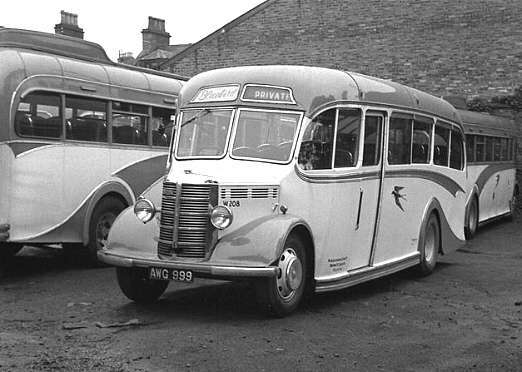
Bedford OB W208 (AWG 999) at Westfield depot, Dundee in the late 1950s. Photo: George Bett.
A few Bedford OBs were built before the war, but wartime utility restrictions and shortages of materials meant that a more spartan model, the Bedford OWB, had to be produced during the hostilities. Having acquired a large number of OWB models from 1942 to 1945, Alexander started in 1946 to purchase the more comfortable and less restricted Bedford OB when it came back into production. A total of 43 OB coaches joined the fleet between 1946 and 1950, numbered W192-223, W229-238 and W240, with various registrations, but mostly prefixed AWG, BWG and BMS.
As well as standard Duple Vista bodies and some 'oddballs', the majority were bodied by SMT to the Duple Vista design, but with one easily visible modification, in that SMT examples had the entry doors sliding inside the sidewall, whereas Duple examples were outside. W208 was withdrawn in May 1957. The only known survivor is W218 (BWG 39).
1947 - AEC REGAL I
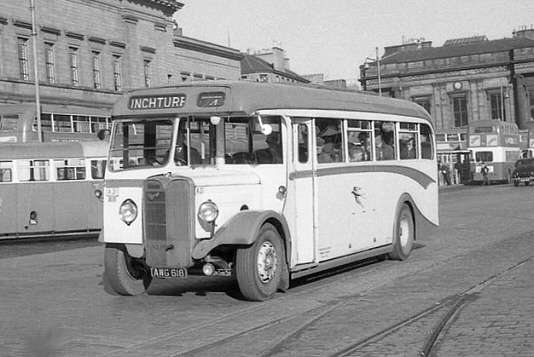
AEC Regal A31 (AWG 618) in Dock Street, Dundee in the mid 1950s. Photo; George Bett.
Alexander, not normally an AEC customer, bought three deliveries of AEC Regal I buses post-war, with 7.7 litre engines. The first (A1-A20) arrived in 1946, bodied by Burlingham and seating 36, the second in 1946-47 (A21-A65) bodied by Alexander and seating 35, and the third in 1947-48 (A66-A82) were by Burlingham again, and also with 35 seats. A31 shown above is from the Alexander-bodied batch, and was delivered in August 1947 in Bluebird livery, as these were considered to be dual-purpose vehicles. The Burlingham examples were painted in the all-blue bus livery, and served as buses only.
Most of these Regals lasted into the late 1960s, and two of the Alexander-bodied examples survive, A36 (AWG 623) and A52 (AWG 639). Both are at the Scottish vintage bus museum.
1947 - AEC REGAL III
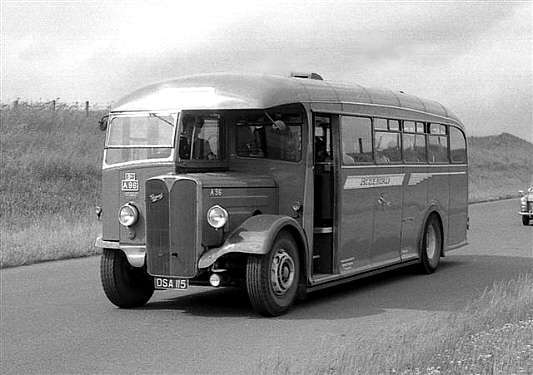
Alexander AEC Regal A96 (DSA 115) of Blairgowrie Depot, ex Sutherland, Peterhead. Location not known, late 1950s. Photo: George Bett
As well as the Regal I, Alexander acquired 23 Regal III models with the more powerful 9.6 litre engine. They came from a variety of sources, the first ones being ten with Burlingham bodies, delivered in November 1947 as AA1-10 (later renumbered AB1-10) (BMS 110-119) for use in the hilly Falkirk area. Then in 1950 Alexander took over the operations of James Sutherland, Peterhead, and sixteen Regals (A83 to A98) joined the fleet as a result. They were a mixed bunch, mostly of pre-war origin, but four were 1947 Regal III coaches, and Alexander numbered them A94-A97 (DSA 113-116).
The Brush bodies on these four were modified by Alexander in 1960/61, increasing the seating capacity from 30 to 35, giving them a repaint in all-blue livery, adding the "Bluebird" flash and logo on the side, and replacing the sliding entrance door with a folding one, now a standard feature for all Alexander vehicles. In this form the four vehicles soldiered on for another 15 years in service as buses. None survive today.
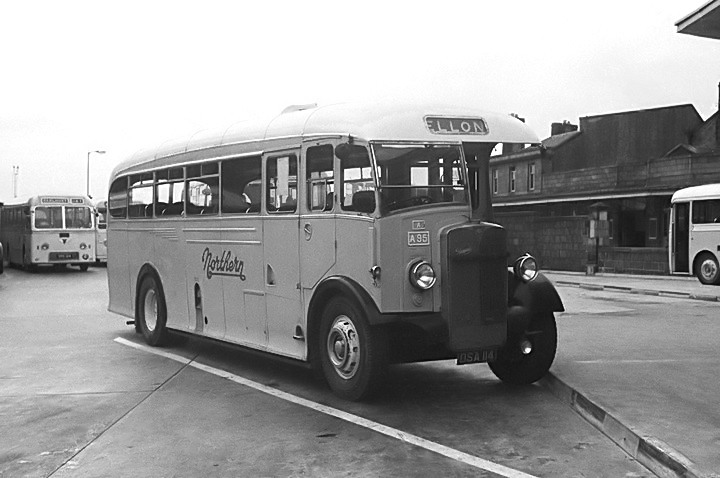
This is A95 (DSA 114) from the same batch, seen on 5 June 1965 at Aberdeen Bus Station. By this time it had been transferred to bus duties. Thanks to Peter Bagshawe for the photo.
1948 - AEC REGAL I
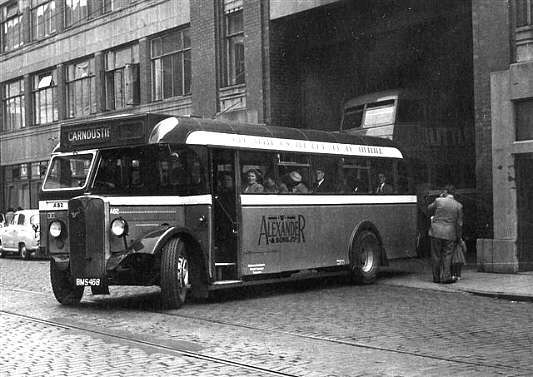
1948 AEC Regal I A82 (BMS 468) leaving the old Lindsay Street bus station/depot in Dundee in 1958. Photo: George Bett
A82 was the very last AEC Regal I delivered new to Alexanders, part of the second Burlingham-bodied delivery of seventeen 35-seat buses, numbered A66-A82 (BMS 100-109 and 462-468). It arrived in March 1948 and was one of the last to go, in December 1965. It must have been quite a sight to see this smart blue machine turning into the streets of Dundee. Sadly none of these Regals survive today.
1948 - LEYLAND TIGER PS1
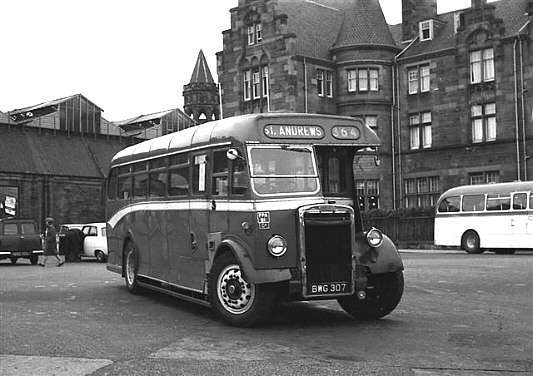
Alexander (Fife) 1948 Tiger FPA81 (BWG 307) of Cupar depot at Station Square, Perth in the early 1960s. Photo: George Bett.
By far the most numerous of Alexander's post-war front-engined coach purchases were of the Leyland Tiger PS1, and virtually all had Alexander C35F bodies. The first 48 were delivered in 1947, and were originally P742-794, continuing the current numbering system, but it was then decided that post-war Tigers would have an A added, so they became PA1- PA48 (AWG 536-560, 701-714) plus an out-of-sequence PA59 (BMS 221). A further 50 arrived in 1948, PA49-58/61-100 (BMS 211-220, BMS 688-702 and BWG 302-326) and the picture shows one of these. There was no PA60.
PA81 in the picture became Alexander (Fife) FPA81 after the 1961 regional divisions were formed, and it was finally retired in June 1967. All these vehicles were originally delivered in Bluebird livery, and many were repainted with red side flashes in 1953 to celebrate the Coronation of Queen Elizabeth II. Two of the coaches are still with us, PA44 (later NPA44) shown at the top of this page, and PA97 (later NPA97) which is with the Rexquote Heritage fleet in Somerset, but is in poor condition.
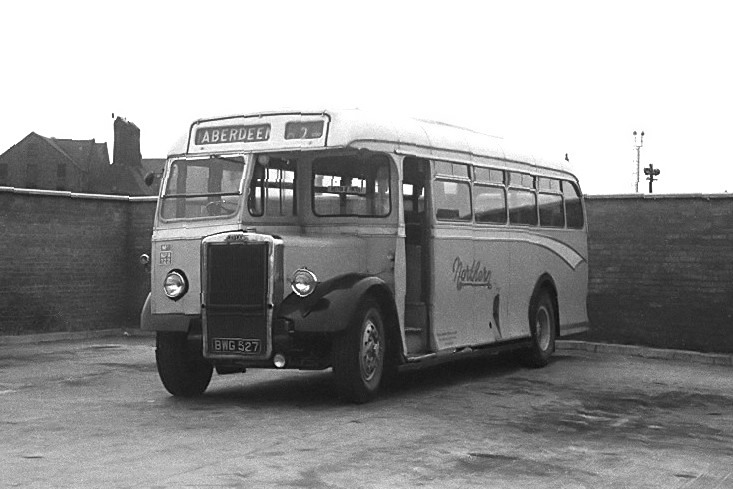
More identical PS1 Tiger coaches were delivered in 1949, and this is Alexander (Northern) NPA122 (BWG 527) seen on 5 June 1965 at Aberdeen Bus Station, relegated to bus duties in its latter days. Photo by Peter Bagshawe.
1948 - DAIMLER CVD6
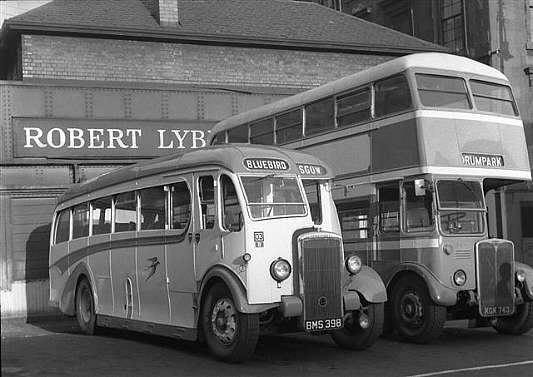
Daimler CVD6 D3 (BMS 398) of Balfron Depot, at Glasgow in the late 1950s, alongside ex-London Transport Cravens RT1484. Photo: George Bett.
Alexander acquired 35 halfcab Daimler CVD6 coaches in the period 1947-49, D1-D35 (AWG 896, BMS 397- 425, BWG 570-574) and a further thirteen full-front coaches in 1951, D36-48 (DMS 549-561). All the halfcabs received off-the-shelf Burlingham C33F bodies, and the majority served until 1965 (including D3 above), some even lasting until 1970. Three of these Daimlers are still around (D10, D19 and D20).
The presence of ex London Transport Cravens RT1484 (KGK 743) is also of interest. New in 1949, it was retired early (the Cravens-built RTs were non-standard, with 5-bay bodies instead of the usual 4, so they were moved out of the fleet relatively quickly) and bought, with two others, by Glasgow operator Lowland Motorways in 1957 for local services. When Lowland was acquired by Scottish Omnibuses the following year, the RTs came as part of the deal, and continued to work in Glasgow for some time.
1949 - BEDFORD OB
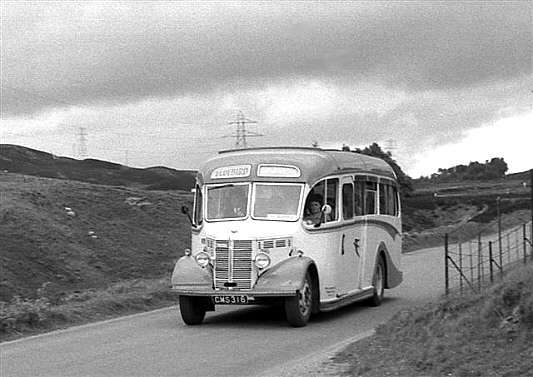
The classic Duple-bodied Bedford OB, Alexander W238 (CMS 316) in the early 1960s. Photo: George Bett.
It doesn't look like a very pleasant day as petrol-engined W238 wends its way to somewhere (George can't remember where he took this shot). The Duple Vista body on this example differs from the 1947 SMT-bodied W208 shown above because the door slides outside the bodywork. Five OBs (W234-238) were bought in 1949 (the last year Alexander bought any), and this was the very last one of all. It was retired in 1963.
1949 - LEYLAND TIGER PS1
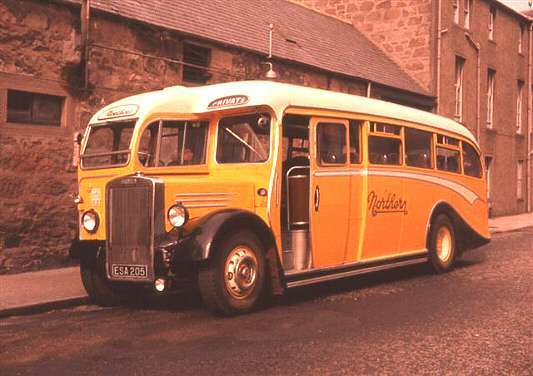
Alexander (Northern) Tiger PS1 NPA202 (ESA 205) at Stonehaven, 16 June 1967. Photo: George Bett.
The final year of Alexander's huge intake of PS1 Tigers was 1950, and amongst them were six with standard Duple bodies which joined the fleet in March 1950 with the takeover of James Sutherland, Peterhead, numbers PA197-202 (EAV 458-461, EAV 636 and ESA 205). The first five dated from 1948, but PA202 was built in March 1949 and, like the others, was put into Bluebird livery. After the regional divisions were formed in 1961, it was allocated to Northern and received their yellow livery, becoming NPA202 and finally retiring in October 1969. The first of the batch, PA197, is a survivor.
For more Alexander buses see 1930s single deckers and 1950s Single Deckers.
For many other buses, have a look at all the other profiles on the Classic Buses menu page.
SOME LINKS WITHIN THIS WEBSITE: Home Email Links THE COMPLETE WEBSITE MENU Events Diary Halfcab list Small-Ads Classic Irish Buses Classic Manx Buses